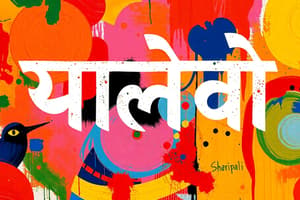Podcast
Questions and Answers
Explain the etymological origin of the name 'Hindi' and what it signifies.
Explain the etymological origin of the name 'Hindi' and what it signifies.
The name 'Hindi' is derived from the Persian word 'Hind,' which means 'land of the Indus River'.
Describe the linguistic lineage of Old Hindi, tracing its development from Sanskrit.
Describe the linguistic lineage of Old Hindi, tracing its development from Sanskrit.
Old Hindi evolved from Apabhramsa, which came from medieval Indo-Aryan languages, derived from early Prakrit languages, which in turn came from Sanskrit.
What dialect serves as the foundation for Modern Standard Hindi, and where is it primarily spoken?
What dialect serves as the foundation for Modern Standard Hindi, and where is it primarily spoken?
Modern Standard Hindi is based on the Khariboli dialect, which is spoken in and around Delhi.
Identify three grammatical features of Hindi that indicate grammatical relations within the language. Give an example of each.
Identify three grammatical features of Hindi that indicate grammatical relations within the language. Give an example of each.
Describe the typical word order in Hindi sentences and note any variations.
Describe the typical word order in Hindi sentences and note any variations.
Name the primary script used to write Hindi. What type of script is it, and what are two notable characteristics of this script?
Name the primary script used to write Hindi. What type of script is it, and what are two notable characteristics of this script?
List three states within India where Hindi is widely spoken.
List three states within India where Hindi is widely spoken.
Besides India, name three countries where there is a significant Hindi-speaking diaspora.
Besides India, name three countries where there is a significant Hindi-speaking diaspora.
What is the constitutional status of English alongside Hindi in the Indian government?
What is the constitutional status of English alongside Hindi in the Indian government?
Explain the primary differences between Hindi and Urdu, and what is the name given when they are considered the same language?
Explain the primary differences between Hindi and Urdu, and what is the name given when they are considered the same language?
How did the Bhakti movement influence early Hindi literature, and can you name two prominent poets from this period?
How did the Bhakti movement influence early Hindi literature, and can you name two prominent poets from this period?
What role has Bollywood played in the influence and spread of the Hindi language?
What role has Bollywood played in the influence and spread of the Hindi language?
What is the importance of Khariboli in the context of Hindi dialects?
What is the importance of Khariboli in the context of Hindi dialects?
Name two significant figures in modern Hindi literature and briefly describe their contributions.
Name two significant figures in modern Hindi literature and briefly describe their contributions.
What are some of the challenges Hindi faces despite its official status and widespread use in India?
What are some of the challenges Hindi faces despite its official status and widespread use in India?
Explain how increasing Sanskrit vocabulary in Hindi and Persian/Arabic vocabulary in Urdu creates a difference between the languages.
Explain how increasing Sanskrit vocabulary in Hindi and Persian/Arabic vocabulary in Urdu creates a difference between the languages.
Why is it important to modernize and promote Hindi on the internet and in digital media?
Why is it important to modernize and promote Hindi on the internet and in digital media?
What are some other languages and cultures that Hindi has influenced and what is the primary way that this influence has occurred?
What are some other languages and cultures that Hindi has influenced and what is the primary way that this influence has occurred?
Flashcards
What is Hindi?
What is Hindi?
An Indo-Aryan language, serving as an official language of the Union government of India, derived from Persian.
Origins of Hindi
Origins of Hindi
Evolved from Apabhramsa, descended from Prakrit, which in turn came from Sanskrit. Modern Standard Hindi is based on Khariboli dialect.
Hindi Grammar
Hindi Grammar
Nouns, pronouns, adjectives, and verbs change form based on grammatical relations like gender, number and case.
Typical Word Order
Typical Word Order
Signup and view all the flashcards
Loanwords in Hindi
Loanwords in Hindi
Signup and view all the flashcards
Devanagari Script
Devanagari Script
Signup and view all the flashcards
Hindi Belt States
Hindi Belt States
Signup and view all the flashcards
Hindi-Speaking Diaspora
Hindi-Speaking Diaspora
Signup and view all the flashcards
Hindi (Official Status)
Hindi (Official Status)
Signup and view all the flashcards
Hindustani
Hindustani
Signup and view all the flashcards
Hindi characteristics
Hindi characteristics
Signup and view all the flashcards
Major Hindi Dialects
Major Hindi Dialects
Signup and view all the flashcards
Khariboli
Khariboli
Signup and view all the flashcards
Bhakti Movement Poets
Bhakti Movement Poets
Signup and view all the flashcards
Modern Hindi Literature Figures
Modern Hindi Literature Figures
Signup and view all the flashcards
Bollywood
Bollywood
Signup and view all the flashcards
Cultural Influence of Hindi
Cultural Influence of Hindi
Signup and view all the flashcards
Challenges for Hindi
Challenges for Hindi
Signup and view all the flashcards
Study Notes
The provided text is identical to the existing study notes. No new information is available to add or modify.
Studying That Suits You
Use AI to generate personalized quizzes and flashcards to suit your learning preferences.




